|
This portion of the site will contain photos of seldom seen Homer Laughlin pieces. The pictures come from research materials assembled by Mark Gonzalez, Joanne Jasper, and Jo Cunningham. Most of the pieces are experimentals and were photographed at the factory, however, some have appeared on the open market.
|
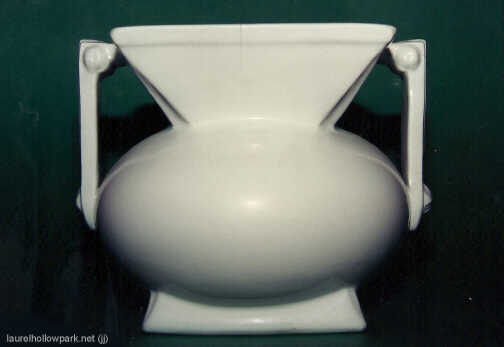 |
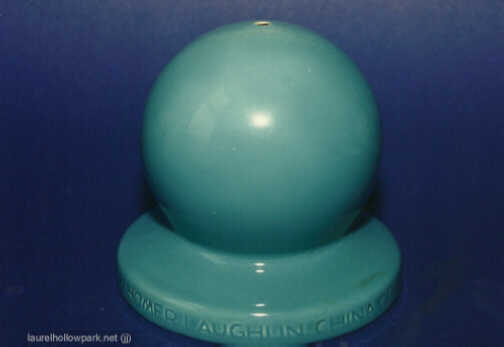 |
Left: This spittoon was originally shown in an issue of The Laughlin Eagle (Fall 1995, Vol. 3, No. 4). It was purchased at an auction in East Liverpool, Ohio in the early 1990s. It is marked with a lion over eagle backstamp. This was probably a hotelware piece, however it has not been found in any of the known HLC catalogs.
Right: The round piece has "Homer Laughlin China Co" across its base. Unfortunately, that is all I know about it. I wish I had more information on this as to when it was made and why.
|
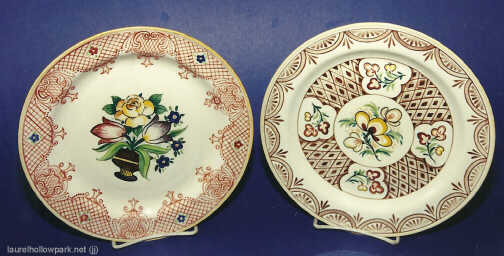 |
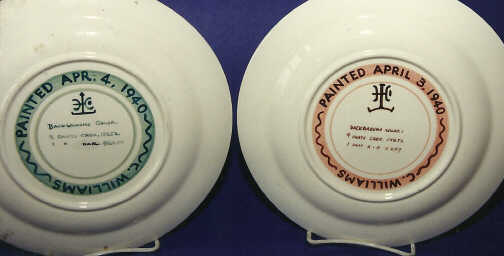 |
Left: Hand-painted plates by Charles Williams from 1940 on the Nautilus shape.
Right: Backs of the hand-painted plates with notes on the date and combination of colors used.
|
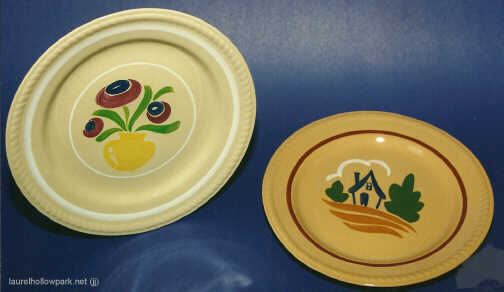 |
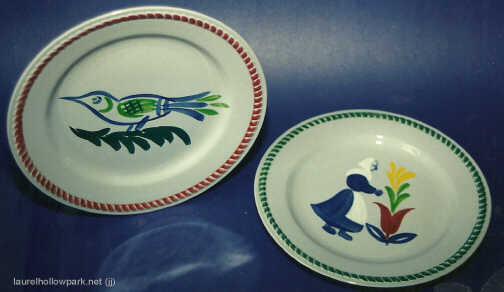 |
Left: Hand-Painted Peasant Ware trials from late 1939 to early 1940 on the rope (Kraft) shape. The pattern on the left wasn't used, but the house on the right was (minus the red verge trim). It appeared with three other designs to make up the Peasant Ware line.
Right: More Peasant Ware, this time on Kraft Blue. Both of these Peasant Ware trial pictures were published in black and white form in the Winter 1997 issue of The Laughlin Eagle. For more on Peasant Ware, see this page.
|
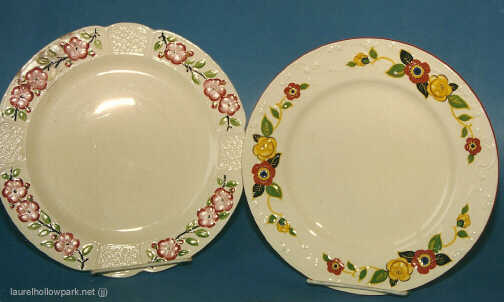 |
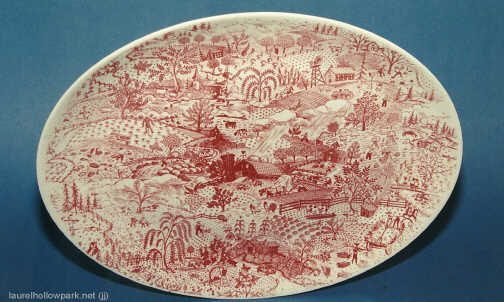 |
Left: The plate on the right is rather unremarkable. It is pattern OS-81 on embossed OvenServe. However, the plate on the left is a trial piece. The embossed blossoms have underglaze hand-painted details. It carries a 1933 Homer Laughlin backstamp.
Right: The underglaze Dura-Print treatment on this Rhythm shape platter comes from the mid-1950s. The Rhythm flatware for this line will have the pattern in green with Charm House shape hollowware in solid dark green. This is the only example I've seen in red instead of the standard green.
|
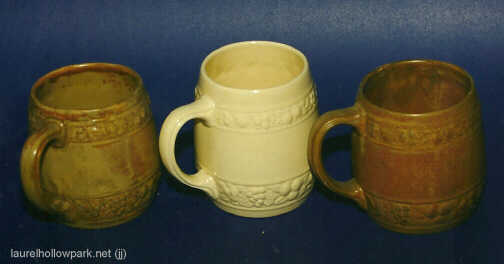 |
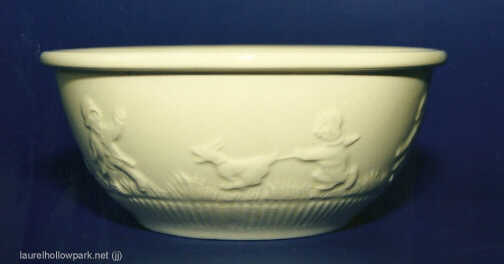 |
Left: The Beer Steins were made in 1933. At least one has been found in Wells Art Glazes' leaf green. It can bee seen on this page with some of designer Frederick Rhead's notes. The ivory example in the center is slightly taller than the other two.
Right: An ivory childs' bowl. Circa 1930s.
|
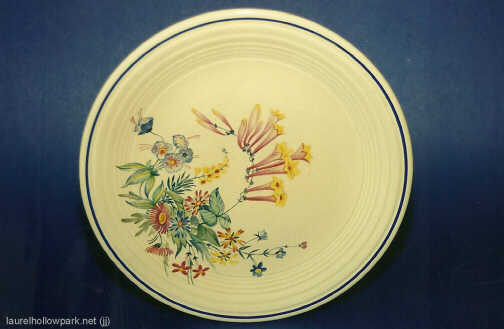 |
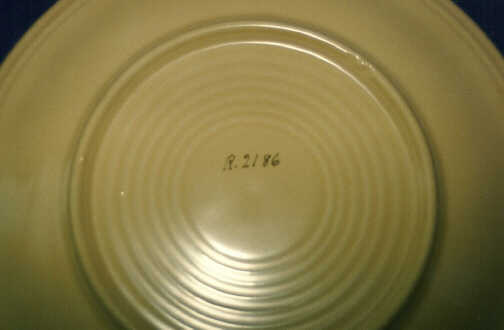 |
Left: Fiesta ivory plate with decal and blue trim. This is a trial piece with an "R" decoration number. Before treatments were given official numbers, they were generally given a reference number. Once a drawing or sample of a decoration was approved, it was given a proper number which usually denotes the shape or customer. (As in VR-128 for a treatment on Virginia Rose, or MW-101 - a treatment for Montgomery Wards.) The reference number for this particular plate is R.2186.
Right: Back of the Fiesta trial plate with reference number, R.2186.
|
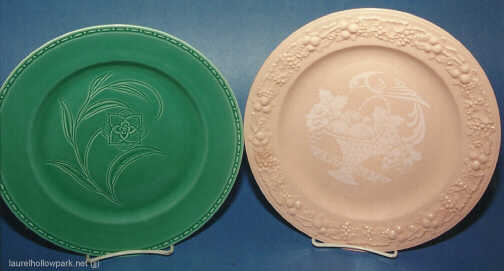 |
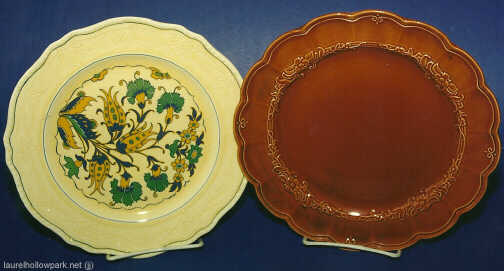 |
Left: The green plate on the left is a Georgian Eggshell piece with an etched design. The pink Theme Eggshell plate on the right has a white treatment. It is very similar to the process used by Taylor, Smith & Taylor's Coral Craft line of the same time period.
Right: The light yellow glazed plate on the left is Newell. It may be hard to see, but there is a lightly etched design along the wide rim. To the right is a scalloped brown plate. The embossing along the verge should look familiar to HLC collectors since it is the same found on the Coronet shape. This plate is more than likely one of the many trial pieces Rhead noted making in developing the Coronet line.
|
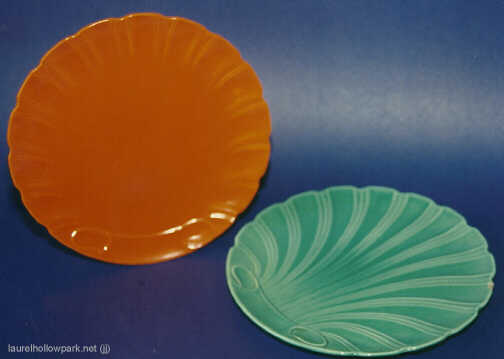 |
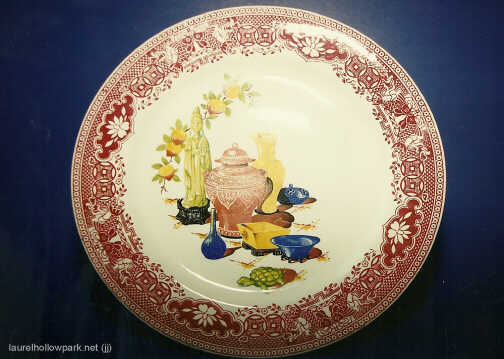 |
Left: Shell plate trials were made in 1938 and 1939 in light green, yellow, turquoise and red. Rhead notes in his journals these were made for Proctor & Gamble. Shown here are the two different styles - a red one with a clear center, and a green one with the shell embossing going clear across the plate. Several red examples have been found outside the factory with the embossing across the plate. They measure 10 1/2" across and are unmarked.
Right: The decal is Chinese Green Goddess and usually found on the Swing Eggshell shape. Here it appears on a Nautilus plate complete with a Willow-theme border in red.
|
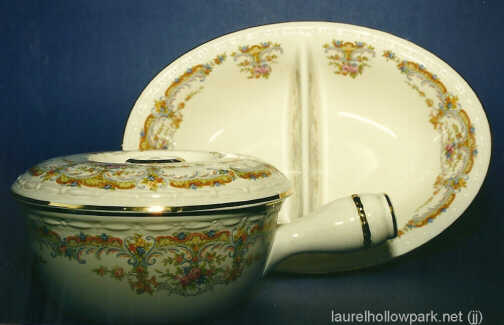 |
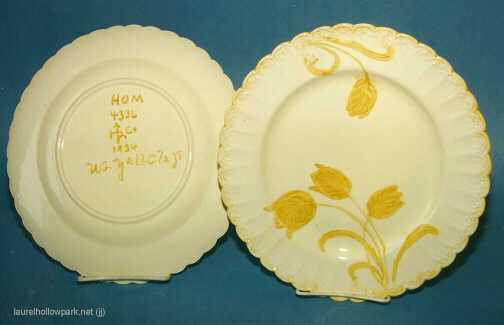 |
Left: Georgian OvenServe (or Georgian Kitchenware) was made in mid-1934. Only six pieces make up the line and it is very hard to find. These are two pieces I've yet to find in the collector market; the French casserole and divided baker. For more on Georgian OvenServe, see the middle of this page.
Right: A pair of scalloped plates with underglaze hand-painted flowers. The reverse of the plate on the left reads, HOM 4436 HLC 1934 U. G. Yellow Glaze.
|
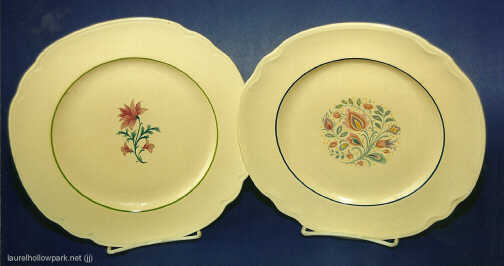 |
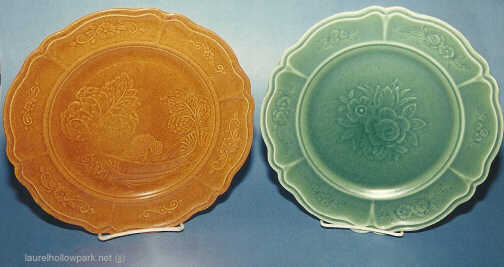 |
Left: Decalled scalloped plates that never went into production.
Right: A pair of Tea Rose shape plates with etched designs.
|
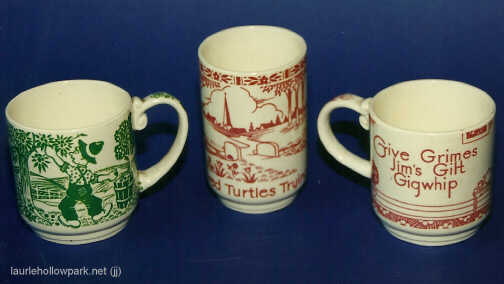 |
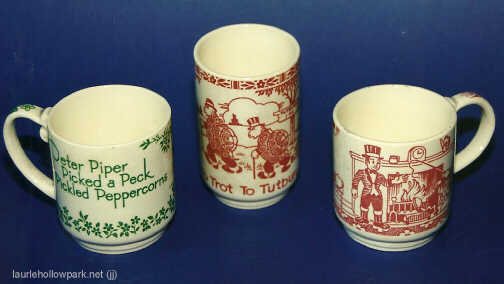 |
 |
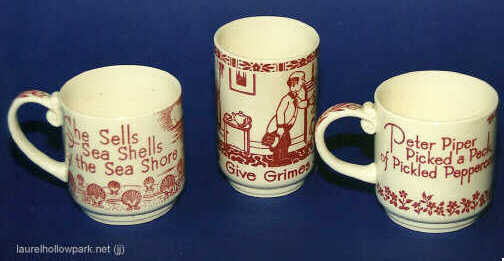 |
|
These four pictures show examples of HLC's Tongue Twister Series from 1941. Once in a while a piece outside the factory can be found, but they are rare. Besides the items shown here, there are also plates, a creamer, and at least two different styles of child's feeders. Some of the concept art for Tongue Twister can be seen in the middle of this page.
|
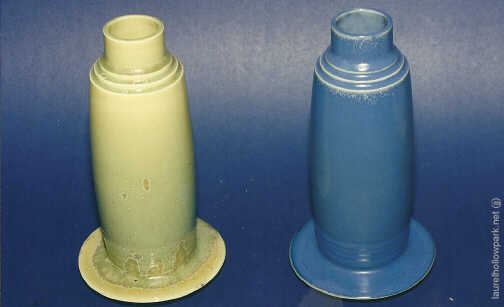 |
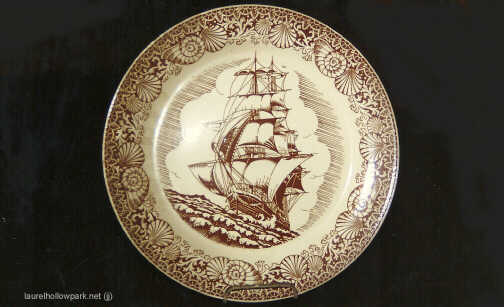 |
Left: A pair of trial vases, possibly bud vases, in odd galzes.
Right: "Famous Old Ships" was a proposed line from the early 1940s. Each piece was to be decorated with an all over, single color, underglaze transfer design. Examples have in red and blue on Nautilus Eggshell and Theme Eggshell are on display at Grave Creek Mound Archeological Complex in Moundsville, West Virginia (see this page). HLC seldom used brown as a transfer color which makes this plate even more unusual.
|
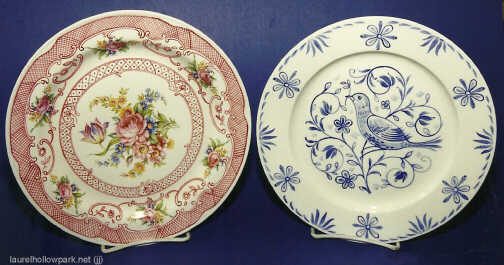 |
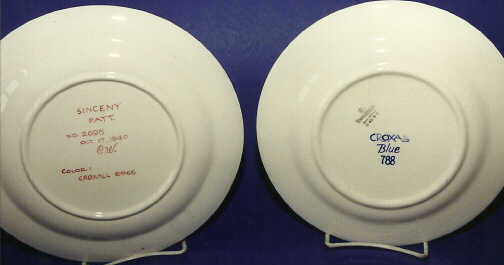 |
Left: The plate on the left has multiple floral decals, but the red lattice work is all hand-painted. The example on the right has no decals. The entire piece was hand-painted.
Right: Here are the backs of the hand-painted plates with notes on the designs: left, SINCENY PATT. No. 2695, Oct. 17, 1940. C.W. COLOR: CROXALL 6966. The "C.W." is probably the artist, Charles Williams. The plate on the right has the general HLC backstamp with date code March 1943 with CROXALL Blue 788.
|
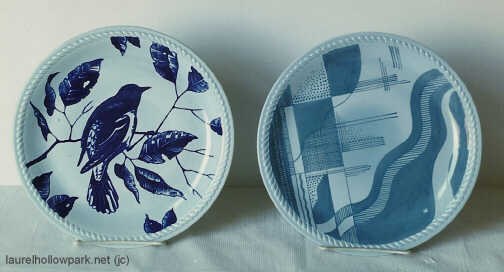 |
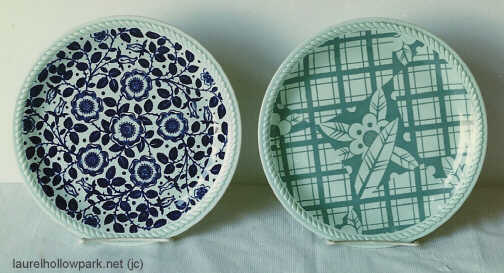 |
|
This particular style of rope border plate was originally made for Fruit Skin Glazes which never went into production. It may look similar to Kraft Blue and Kraft Pink plates, but those shapes have plates with rims. In fact, the only time this style of rope plate was used was in 1942 as a special souvenir plate for Woolworth's stores. (You can read more about Fruit Skin Glazes and the souvenir plate on this page.) The four experimental plates shown look like they were made in the special blue clay used for Kraft Blue and Skytone, but each was given a special underglaze decoration.
|
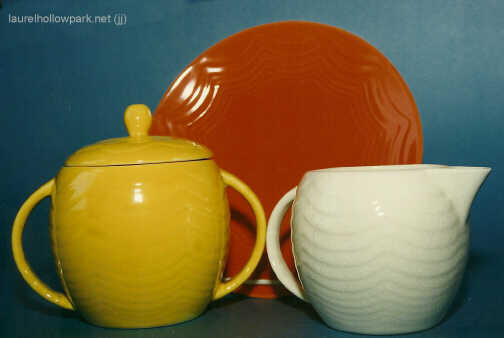 |
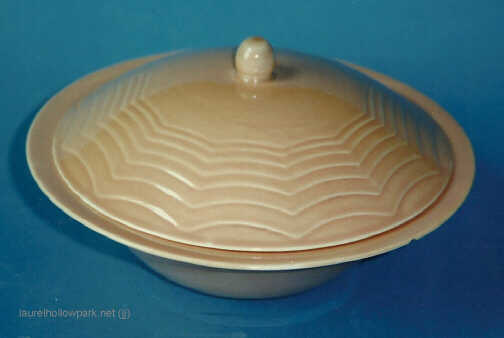 |
|
HLC's Modern Farmer shape in yellow, Fiesta red, and rose. The white creamer has a clear glaze. Its unfortunate Modern Farmer was never made in solid color glazes. The embossing is much more visible in solid colors than their decaled counterparts.
|
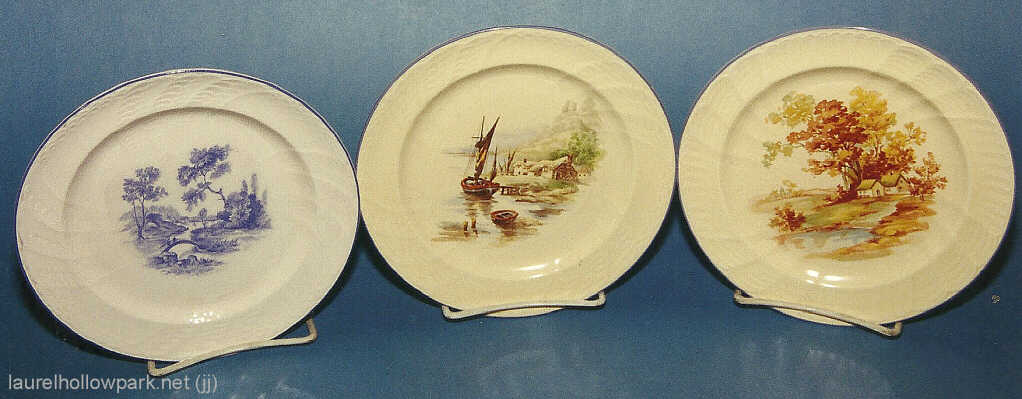 |
|
Experimental plates. The examples in the middle and far right are decorated with reference decals R5012 an R5011, respectively. The spiral and feathered embossing starts towards the center and extends outwards towards the rim. While these pieces don't carry HLC backstamps, they were photographed at the plant roughly twenty-five years ago.
|
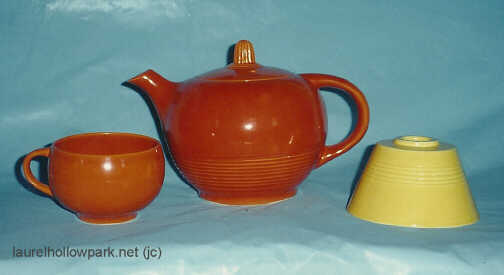 |
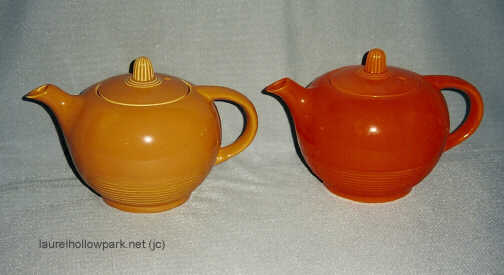 |
|
I have no significant information on the teapots or the cup - which looks more like a coffee cup than teacup. The candleholder however is a trial piece of Harlequin. In April of 1940, three different Harlequin candleholder were made; model 1381 or "1A" which is the version that actually went into production, model 1382 or "2A", the style seen here, and model 1383 or "3B". All three versions were created by modeler Al Kraft.
|
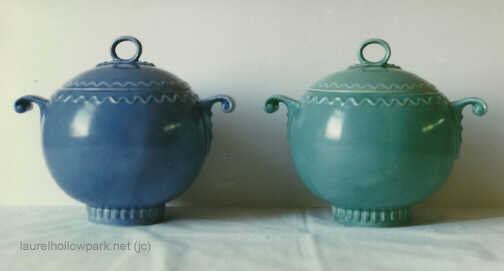 |
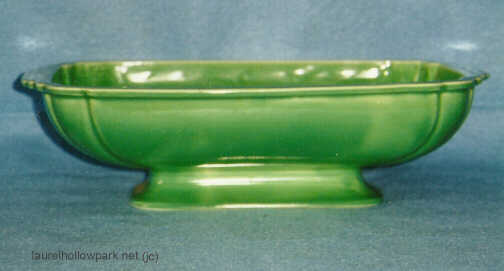 |
Left: A pair of experimental cookie jars
Right: An experimental Riviera console bowl in light green. Measuring approximately 12" by 8", it was made in June of 1942. Matching tall candlesticks were made a month later.
|
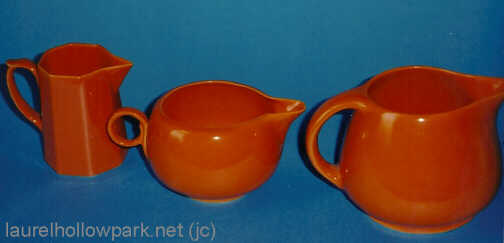 |
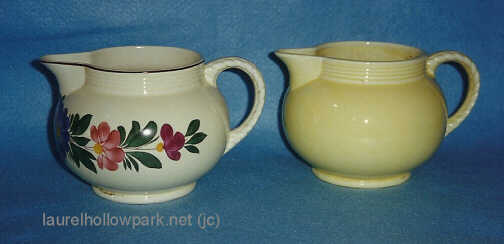 |
Left: All in Fiesta red; Yellowstone jug, Swing gravy (model number 1076), and Kitchen Kraft jug.
Right: Experimental jugs, model 1209 - with and without decals. They were made in March of 1939.
|
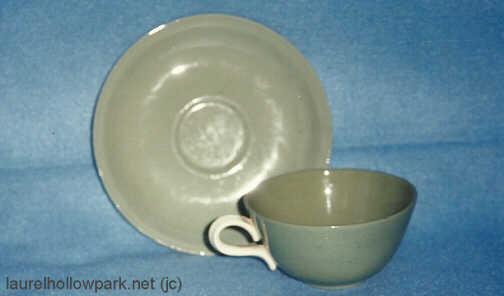 |
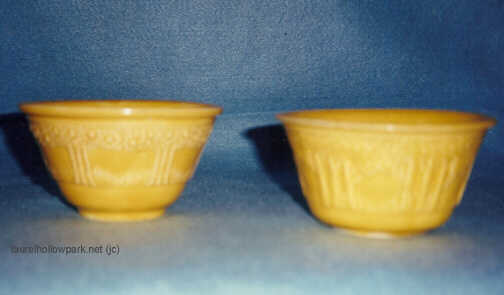 |
Left: A variant of Skytone and Suntone, this cup and saucer has a gray colored clay body with white handle and clear glaze.
Right: The apple tree bowl on the left is the standard HLC shape. On the right is a Japanese copy. An article ran in the East Liverpool Review on October 13, 1936 regarding Japanese copies of U.S. dinnerware products. The article reads in part, "...Two striking examples of the unscrupulous copying made be found in likeness of the Homer Laughlin China Co. Coronet tea set and their Appletree mixing bowls recently put on the market bearing the hallmark, "Made in Japan."
|
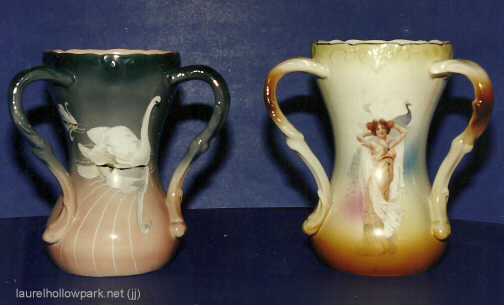 |
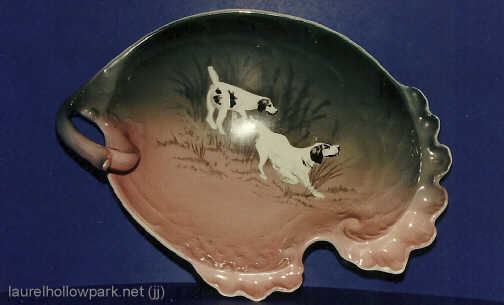 |
|
Examples of Laughlin Art China you can expect to find on the collector market; loving cups with "White Pets" on the left and "Juno" on the right. The photo on the right is of a handled nut dish with "White Pets."
|
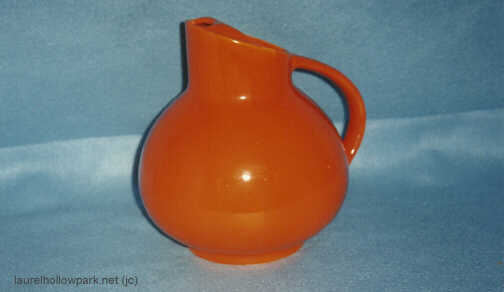 |
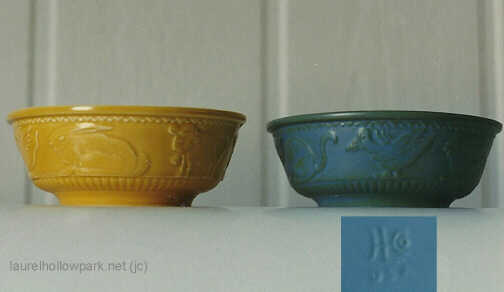 |
Left: The red jug is model 1053 from March 1938. It is listed as having a capacity of 94.66 oz. An earlier version, model 1050, was made complete with a lid.
Right: A pair of embossed child's bowls. The inset photo shows a the HLC marking found on the blue bowl.
|
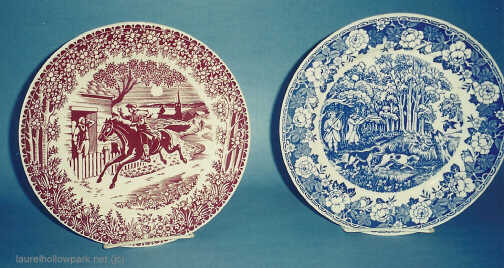 |
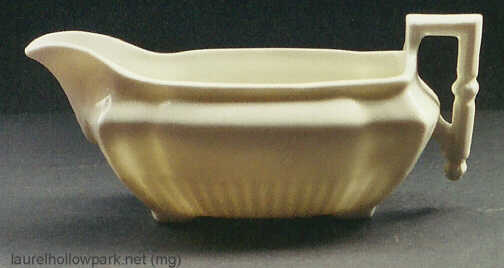 |
Left: Underglaze decorated trial plates
Right: Chelsea gravy. While this isn't an experimental piece, it is somewhat rare. The Chelsea shape was one of HLC's earliest dinnerware lines. It comes from the late 1880s and will be found marked with a horseshoe backstamp. As you can see from the picture, the ware is translucent.
|
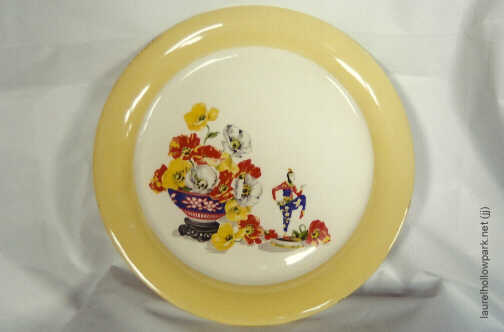 |
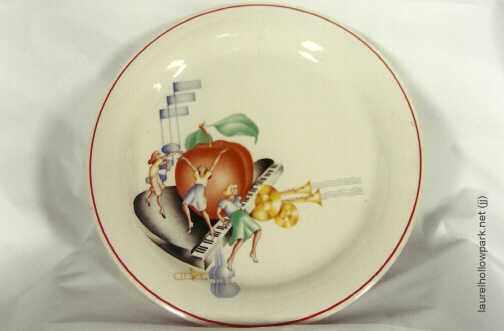 |
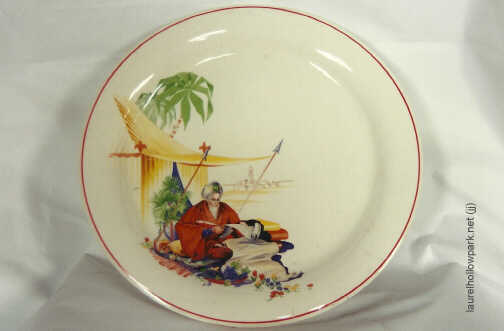 |
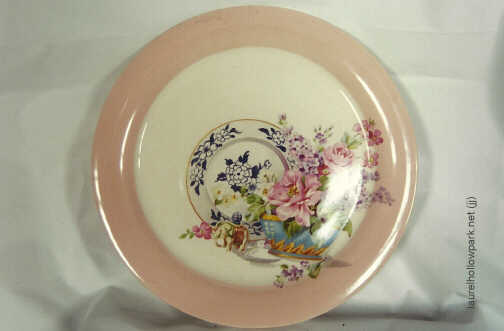 |
|
Examples of trial decals on the Swing shape from the late 1930s.
|
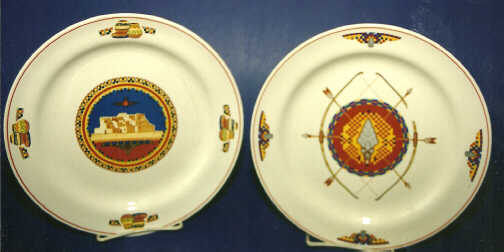 |
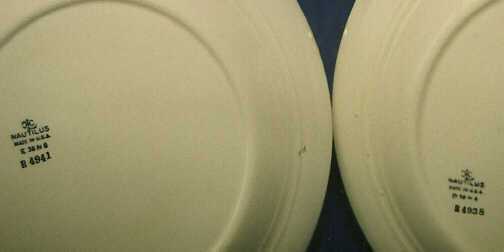 |
Left: "Pueblo" and "Cheyenne" trials on Nautilus plates. The Native American theme decals can be found on the Century shape, but pieces can be rare.
Right: Here the Nautilus trials have their reference decals numbers R4941 for Pueblo, and R4938 for Cheyenne.
|
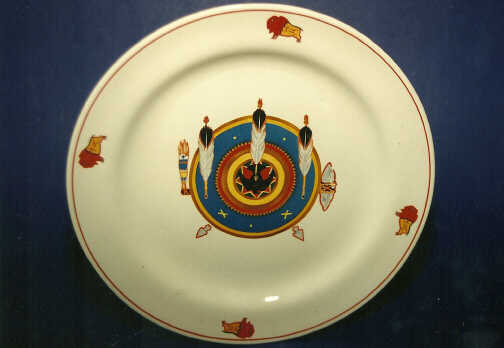 |
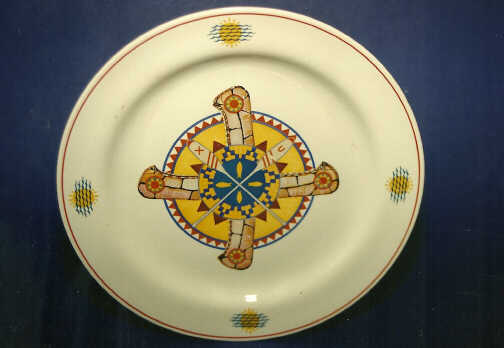 |
|
More Native American decals on Nautilus plates.
|
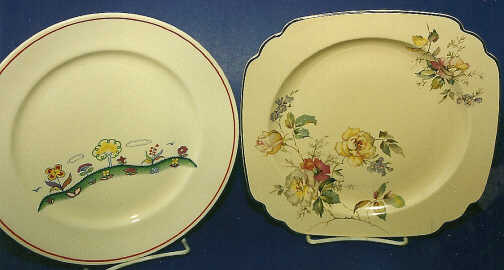 |
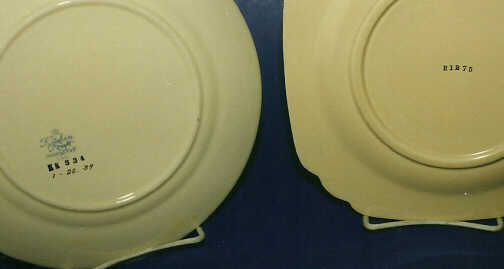 |
|
A pair of shop samples. On the left is a Kitchen Kraft 9" plate and to the right is a decaled Century plate. The back of the Kitchen Kraft plate is stamped with the treatment number KK-334. It is dated January 20, 1939. The Century plate is marked with a reference number R1275.
|
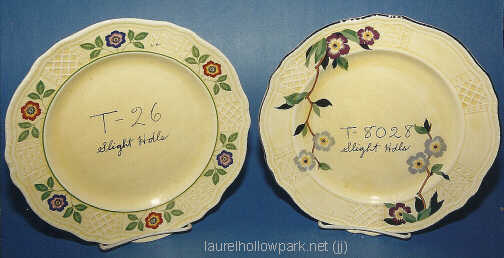 |
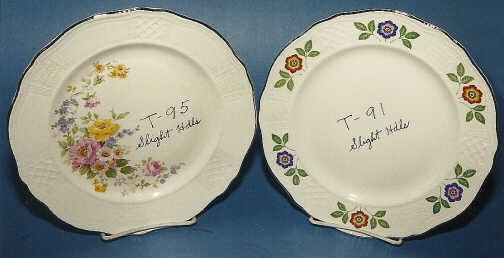 |
|
Trellis sample plates from circa 1930 with their official treatment numbers. The pair on the left are in the light yellow glaze first used on the Newell shape. The pair on the right were glazed in ivory.
|
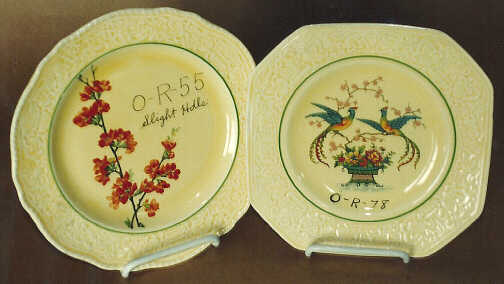 |
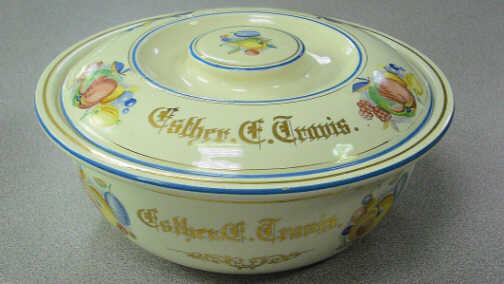 |
Left: Old Roman sample plates. The decal on the round example (OR-55) was also used on the Century shape as MS-22, though without the green verge trim. The decal used for OR-78 also appears on multiple HLC shapes and was even used by other potteries.
Right: A specially decorated Kitchen Kraft casserole made for Esther Travis, circa late 1930s.
|
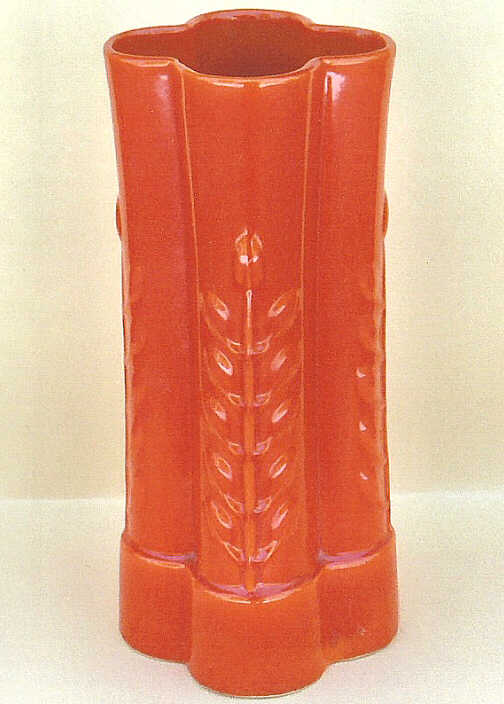 |
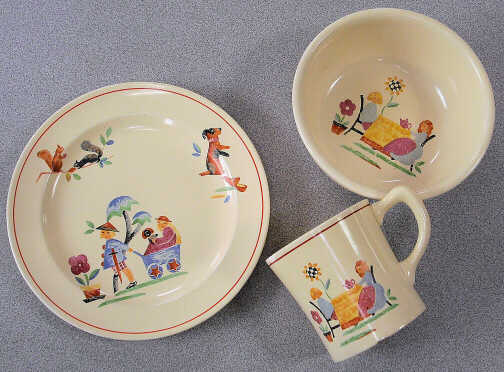 |
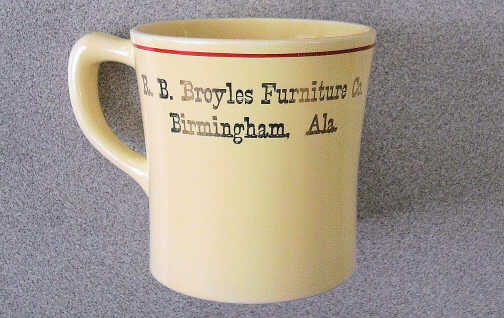 |
Left: The Four Tube or Four Flute vase glazed in Fiesta red. It was made by Frederick Rhead in March of 1936. It is listed in company records as model number 565 and measures 9" by 3 1/8"
Right: A three-piece child's set with decoration number W-1353. This set was made for Broyles Furniture of Birmingham, Alabama in December of 1940.
|
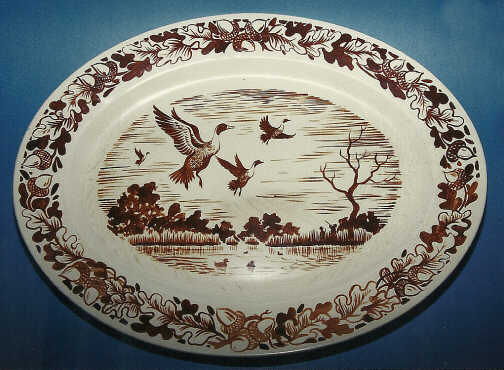 |
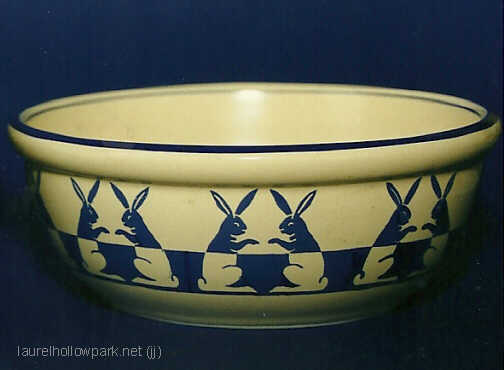 |
Left: Hand-painted oval platter from 1944. On the back is written: Brown GY 158. Probably a sample piece for an underglaze line that never went into production.
Right: A child's bowl in vellum glaze with a blue rabbit underglaze decoration.
|
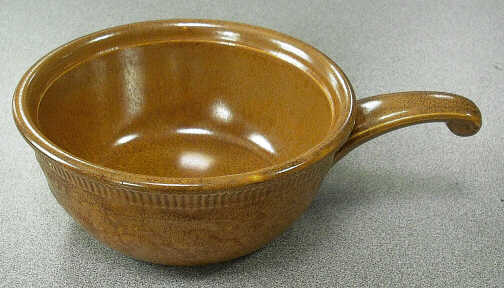 |
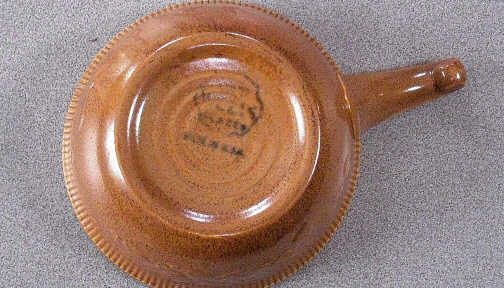 |
|
OvenServe French casserole in the rust, or burnt sienna, art glaze commonly used on the Wells shape. OvenServe pieces have been found in rust, rose, and green, but they are not very common. (The yellow art glaze, a.k.a. melon yellow, was a standard color for OvenServe.) This particular example was found in a large set of Wells dinnerware, all in rust.
|
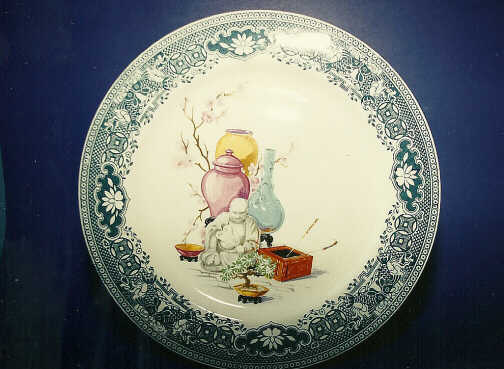 |
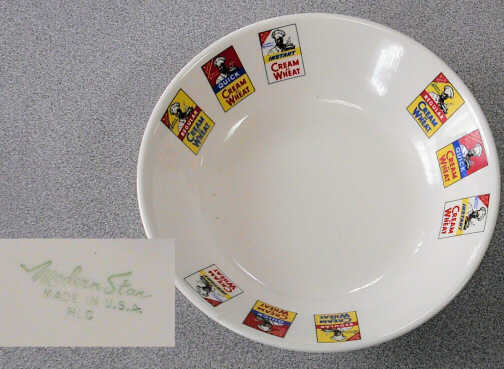 |
|
Left This Chinese theme decal can be found on Swing Eggshell. Here it is paired with an underglaze green border on a Brittany plate.
Right Cream of Wheat oatmeal bowl. What makes this piece odd is the Modern Star backstamp. Modern Star was a special line made for Quaker Oats and has nothing to do with Cream of Wheat.
|
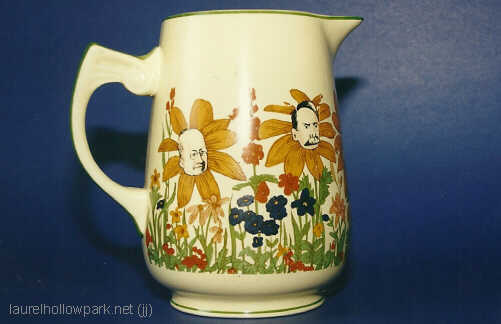 |
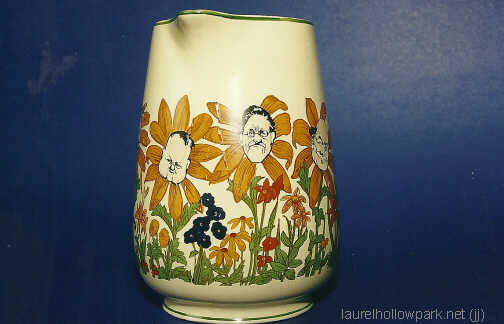 |
|
Wells shape batter jug. This piece was photographed at HLC and was shown in the 1996 Summer issue of The Laughlin Eagle.
|
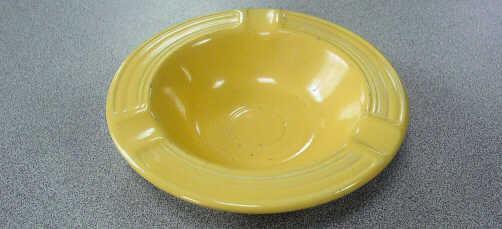 |
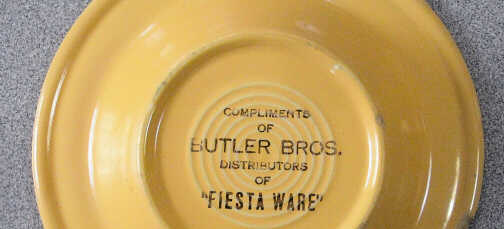 |
|
Fiesta ashtray in yellow. Not an odd or rare piece in itself, but it was marked with a special gold backstamp promoting Butler Brothers. They carried Fiesta in their catalogs for a number of years.
|
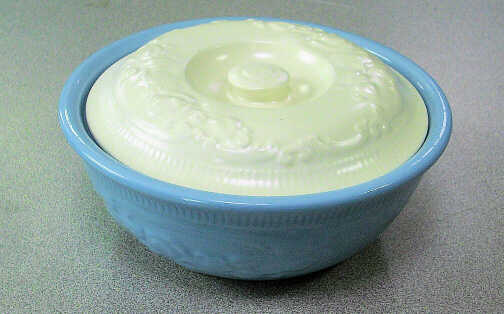 |
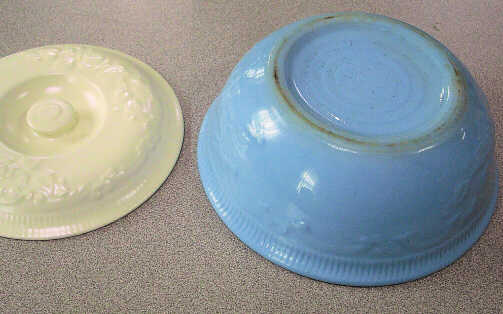 |
|
OvenServe small casserole. The blue color in the base comes from the clay, not the glaze. It is the same blue bodied clay used for Kraft Blue and Skytone. The lid was made in white and given a clear glaze.
|
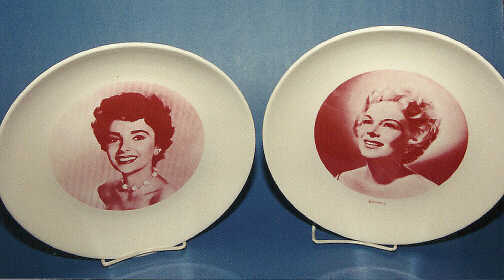 |
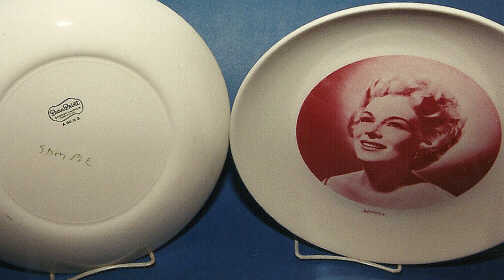 |
|
Sample plates on Dura-Print blanks which look to use photograph prints as transfers.
|
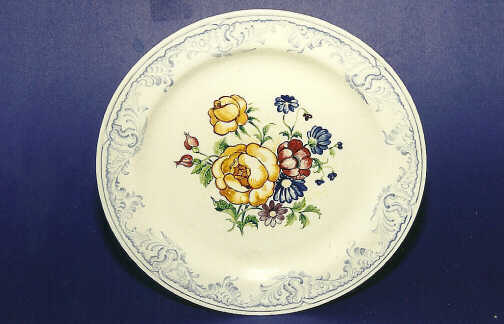 |
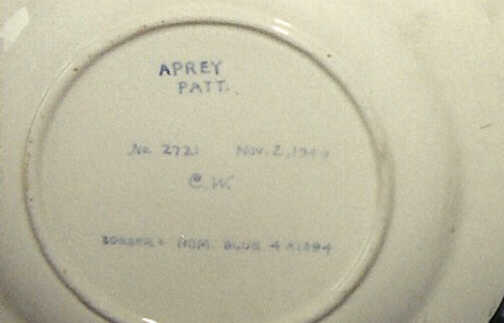 |
|
Sample plate, front and reverse, by Charles Williams. Number 2723. The date on the back is hard to read, but it looks like the early 1940s.
|
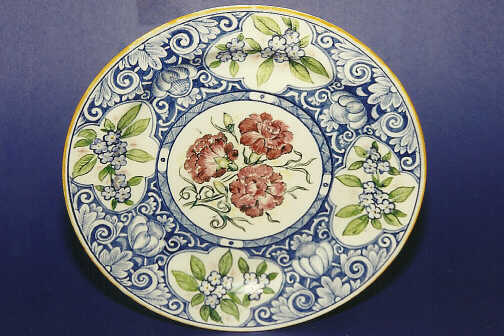 |
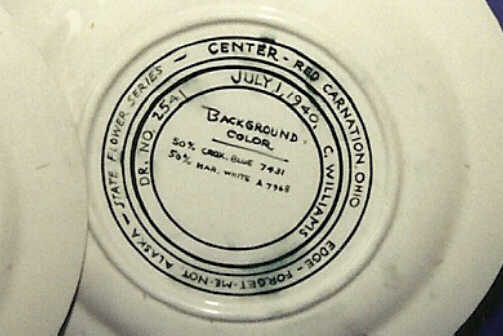 |
|
Sample plate, front and reverse, by Charles Williams. Dated July 1, 1940, this piece references drawing number 2541. Part of a State Flower Series. This one features a red carnation for Ohio.
|
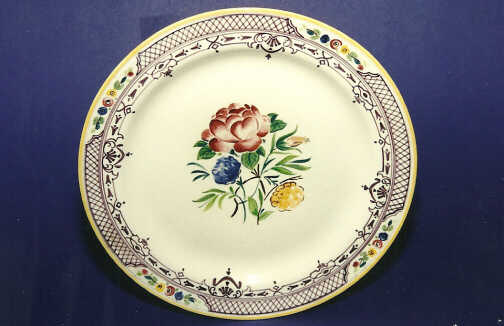 |
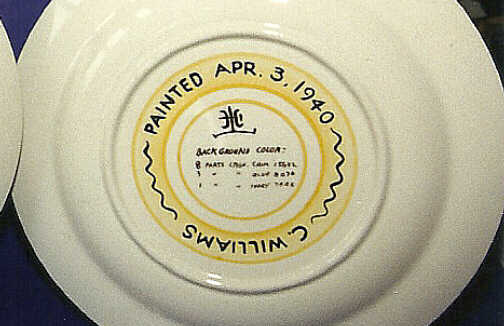 |
|
Sample plate, front and reverse, by Charles Williams. Dated April 3, 1940. The reverse has a listing of the colors Williams used.
|